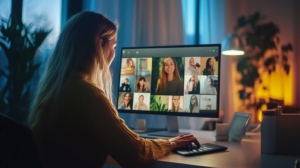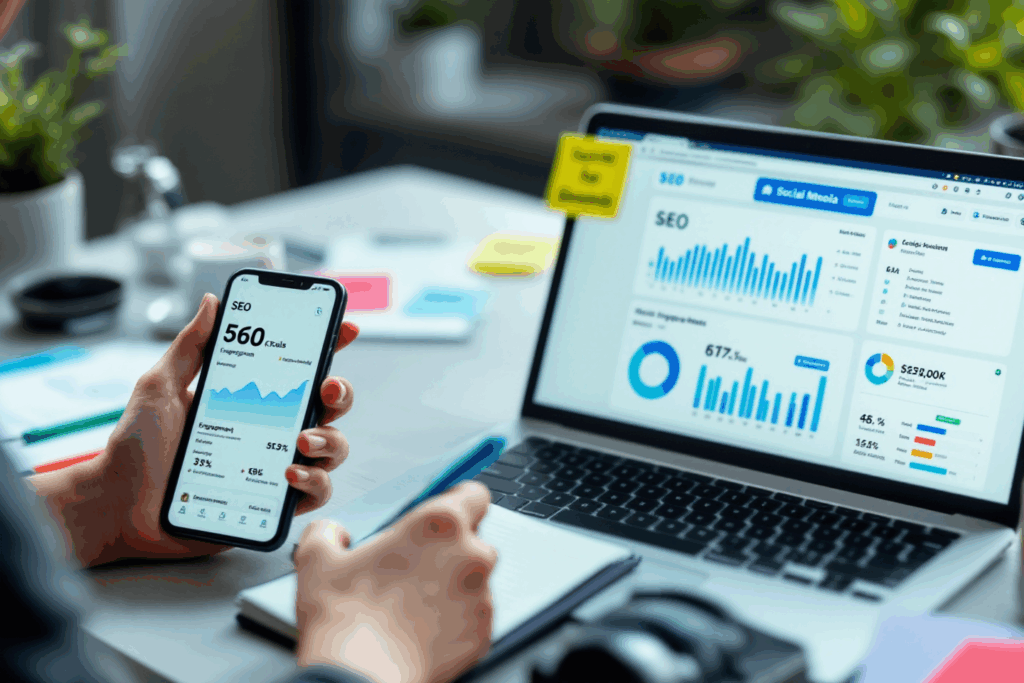
Future (Be going to) 4
English Blogs “Let’s Learn, Explore, and Connect to the World” Future (Be going to) 4 IV. Forming Questions and Negatives in ‘Be Going To’ Effectively



 The rise of digital technology over the past few decades has revolutionized the way we live, work, and interact with one another. Technology is now a fundamental part of our everyday lives, used for everything from communication and entertainment to advanced applications like virtual reality and artificial intelligence. This rapid advancement has brought about numerous conveniences and opportunities, enabling us to stay connected, informed, and productive like never before. However, along with these benefits, technology’s pervasive presence has also introduced challenges, particularly concerning our mental health.
The rise of digital technology over the past few decades has revolutionized the way we live, work, and interact with one another. Technology is now a fundamental part of our everyday lives, used for everything from communication and entertainment to advanced applications like virtual reality and artificial intelligence. This rapid advancement has brought about numerous conveniences and opportunities, enabling us to stay connected, informed, and productive like never before. However, along with these benefits, technology’s pervasive presence has also introduced challenges, particularly concerning our mental health.
In today’s digital world, managing our time effectively online and offline is increasingly important. Digital and real-life balance refers to the ability to manage and harmonize our time and activities between the virtual realm and the physical world. It’s crucial to find a balance that allows us to enjoy the benefits of technology without sacrificing our well-being. With the growing concerns about the impact of technology on mental health, it is imperative to explore how our digital habits influence our psychological state and what measures we can take to maintain a healthy equilibrium.
 Understanding how technology affects our mental health is increasingly important. We must identify and address potential negative consequences as we rely more on digital devices. By studying both the benefits and drawbacks of technology and how it influences our minds, we can develop strategies to use technology more healthily. This blog aims to shed light on these aspects and provide practical insights into balancing digital and real life for better mental health.
Understanding how technology affects our mental health is increasingly important. We must identify and address potential negative consequences as we rely more on digital devices. By studying both the benefits and drawbacks of technology and how it influences our minds, we can develop strategies to use technology more healthily. This blog aims to shed light on these aspects and provide practical insights into balancing digital and real life for better mental health.
Technology has dramatically improved mental health care by making it easier to access, increasing public understanding of mental health issues, and fostering stronger social connections. Here are some key positive impacts:

Technology has expanded access to mental health care. Online therapy platforms and mental health apps have made professional help and self-care tools more convenient and affordable, allowing many people to receive support without the barriers of traditional therapy.

Online platforms have significantly increased awareness and understanding of mental health issues. Websites, social media, and mental health organizations have reduced stigma by sharing information and encouraging open conversations. This has empowered people to seek help and created a more supportive society.

Social media has transformed how we connect with others, creating new ways to find support and community. Online platforms offer spaces where people facing similar challenges can share experiences, offer advice, and find emotional support. This virtual community can be especially helpful for those struggling with mental health.
In summary, while technology presents certain challenges, it offers numerous benefits that can significantly enhance mental health. By increasing accessibility to resources, raising awareness, and fostering social connections, technology plays a vital role in supporting mental well-being in the digital age.
While technology offers many benefits, its pervasive presence also brings significant challenges that can negatively impact mental health. Here are some of the key negative impacts:

Social media can negatively hurt self-esteem and body image. Constant exposure to carefully crafted and often unrealistic images online can lead people to compare themselves unfavorably to others. This can result in feelings of inadequacy and low self-worth, especially among young people.

Cyberbullying and online harassment, made easier by the internet’s anonymity, can severely harm mental health. Unlike traditional bullying, it can happen anytime and anywhere, leaving victims feeling trapped and isolated. Constant online abuse can lead to anxiety, depression, and even suicidal thoughts. Victims often struggle to escape or get help due to the nature of the attacks, causing significant emotional distress and a sense of insecurity.

Excessive technology use can harm mental well-being. The constant stream of notifications and information creates stress and anxiety. Difficulty disconnecting from devices can disrupt sleep and lead to burnout. Technology can also blur personal boundaries, making it hard to relax. It has both benefits and drawbacks for mental health, and it’s important to be aware of the potential negative effects.
The intersection of technology use and mental health has become a focal point of research in recent years. Research has shown how using digital devices can impact our mental health. This section delves into the key findings of these studies, exploring the effects of screen time on sleep patterns and cognitive functions, as well as the role of dopamine and instant gratification in technology addiction.

Numerous studies have examined the relationship between technology use and mental health, revealing a complex interplay of factors. Research published in journals like Cyberpsychology, Behavior, and Social Networking and Journal of the American Medical Association has found correlations between high levels of social media use and an increased number of people with depression, anxiety, and loneliness. For instance, a study by the University of Pennsylvania demonstrated that limiting social media use to 30 minutes daily significantly reduced feelings of loneliness and depression among participants. These findings suggest that while technology can offer social benefits, excessive use may contribute to adverse mental health outcomes.
How Screen Time Affects Sleep and Thinking

Screen time, especially before bed, can harm sleep and thinking. The blue light from screens interferes with sleep, causing problems falling asleep and poor sleep quality. Lack of sleep is connected with mental health issues like stress, anxiety, and depression. Not sleeping enough can also make it harder to think clearly and remember things.

Engaging in social media, gaming, and online shopping can trigger the brain’s reward system, releasing dopamine, a chemical linked to pleasure. This can lead to a cycle of pursuing constant, short-lived rewards from digital experiences. Over time, this can contribute to technology addiction, characterized by compulsive use of digital devices despite negative consequences. Research in Frontiers in Psychology has shown that technology addiction shares similarities with other behavioral addictions, such as gambling, in terms of its impact on the brain’s reward pathways and overall mental health.
In summary, scientific research underscores the need for mindful and balanced technology use. By understanding how technology affects our mental health, we can develop strategies to mitigate its negative impacts and promote healthier digital habits. This knowledge is crucial for individuals, parents, educators, and policymakers striving to foster a more balanced relationship with technology.
Achieving a healthy balance between digital and real life is crucial for maintaining mental well-being in today’s tech-driven world. Here are some effective strategies to help set boundaries with technology use, the importance of digital detoxes, and ways to encourage real-life social interactions and outdoor activities.

1. Establish Tech-Free Zones and Times: Designate particular rooms in your house, like the bedroom or dining room, as technology-free zones. Additionally, set designated times during the day when you refrain from using technology, such as during meals or an hour before bedtime.

2. Use Digital Well-being Tools: Many devices and apps offer monitoring and limiting screen time features. Utilize these tools to set daily usage limits for social media, games, and other distracting applications. This can help you stay aware of your digital habits and make conscious decisions about your technology use.

3. Prioritize Tasks and Set Goals: Organize your day by prioritizing tasks that require focus and creativity without digital distractions. Set clear goals for your screen time, ensuring that it aligns with your personal and professional objectives rather than mindless scrolling.

4. Practice Mindful Usage: Be intentional about your technology use by asking yourself why you are reaching for your device. Are you using it for a specific purpose or succumbing to boredom or habit? Mindful usage can reduce unnecessary screen time and promote healthier digital habits.

1. Scheduled Digital Detoxes: Plan regular breaks from digital devices, such as a weekend digital detox or a screen-free day each week. Use this time to do activities that don’t require screens, like reading, working out, or spending time with family and friends.

2. Benefits of Unplugging: Disconnecting from technology helps your mind relax and recover, lessening feelings of stress and worry. It can also improve sleep quality by minimizing exposure to blue light before bedtime. Disconnecting helps you reconnect with yourself and the physical world around you.

3. Encouraging Real-Life Social Interactions and Outdoor Activities:

4. Foster Face-to-Face Connections: Make a conscious effort to engage in real-life social interactions. Bond with friends and family, join community events, or find groups with shared interests. Face-to-face interactions provide emotional support and strengthen relationships, which are essential for mental health.

5. Embrace Outdoor Activities: Spending time outdoors can significantly improve mental health by reducing stress, lifting your mood, and boosting overall well-being. Enjoy activities like hiking, biking, or simply walking in nature. These activities provide a break from screens and offer physical exercise and relaxation opportunities.

6. Combine Social and Outdoor Activities: Organize group activities that involve outdoor experiences, such as picnics, sports, or nature walks. This promotes physical health, enhances social bonds, and provides a refreshing break from digital environments.
In conclusion, balancing digital and real-life requires conscious effort and intentionality. By setting limits on technology use, taking breaks from screens, and spending more time with people and outdoors, you can improve your relationship with technology and enhance your mental well-being. These strategies empower you to enjoy the benefits of technology without compromising your overall quality of life.
 Parents and educators are pivotal in guiding children and adolescents toward healthy technology use. They can help young people navigate the digital world safely and effectively by fostering an environment that promotes balance and awareness.
Parents and educators are pivotal in guiding children and adolescents toward healthy technology use. They can help young people navigate the digital world safely and effectively by fostering an environment that promotes balance and awareness.
1. Modeling Balanced Behavior: Parents and educators should lead by example, demonstrating balanced technology use. Setting limits on screen time and prioritizing offline activities can show children the importance of a healthy digital balance.
2. Setting Clear Boundaries: Establish rules for technology use, such as designated screen-free times or areas in the home and school. Promote physical activity, hobbies, and in-person social interaction for children.
3. Educating About Online Safety: Educate children about internet dangers, such as cyberbullying, privacy risks, and the importance of thinking critically about online information. Emphasize the need for respectful online behavior and the impact of their digital footprint.

1. Incorporating Digital Literacy into the Curriculum: Schools should teach students how to use technology responsibly, stay safe online, and understand the impact of their online actions. These programs should also cover the benefits and risks associated with digital tools.
2. Mental Health Education: Mental health awareness should be a key component of the educational curriculum. Equipping students with mental health knowledge can help them identify signs of stress, anxiety, or depression and encourage them to seek support when needed.
3. Workshops and Seminars: Host workshops and seminars for parents, teachers, and students to discuss technology’s impact on mental health. These events can offer practical tips and strategies for managing technology use and promoting mental well-being.
1. Foster Open Communication: Build a safe space for young people to discuss technology use and mental health concerns. Open dialogue helps understand their experiences and challenges, making it easier to provide guidance and support.
2. Providing Resources and Support: Ensure that children and adolescents have access to mental health resources, including counseling services and helplines. Schools can also provide materials on managing screen time and dealing with online pressures.
3. Building a Community of Support: Create a support network involving parents, teachers, and mental health professionals. This community can collaborate to monitor the impact of technology on students’ mental health and implement effective interventions when necessary.
 In conclusion, educators and parents play a crucial role in shaping the digital habits of the younger generation. By modeling balanced behavior, providing education, and creating a supportive environment, they can help children and adolescents navigate the complexities of the digital world while maintaining their mental health and well-being.
In conclusion, educators and parents play a crucial role in shaping the digital habits of the younger generation. By modeling balanced behavior, providing education, and creating a supportive environment, they can help children and adolescents navigate the complexities of the digital world while maintaining their mental health and well-being.
The shift to digital communication and remote work has dramatically changed our work. While offering greater flexibility, these changes have also created new challenges that can affect employee well-being.

Remote work and digital communication tools, such as video conferencing and instant messaging, have become integral to many organizations. While they facilitate seamless communication and collaboration, they can blur the lines between work and personal life. This constant connectivity can increase stress and burnout, as employees may feel compelled to be available around the clock. Blending work and home life can lead to feelings of isolation and reduced job satisfaction, negatively impacting overall mental health.

Companies can improve mental health in remote work environments by setting clear work hours, encouraging breaks, and providing mental health resources. Building a supportive and nurturing workplace culture where employees feel comfortable discussing mental health is also essential.

Balancing productivity and mental health in a tech-driven work environment requires planning and support. Managers should prioritize realistic workloads and deadlines to prevent overwhelming employees. Regular check-ins and feedback sessions can help identify any issues early and provide opportunities for support. Incorporating team-building activities and fostering social connections among remote workers can alleviate feelings of isolation.
Furthermore, providing training on digital literacy and effective time management can empower employees to use technology efficiently without compromising their mental health.
In conclusion, while technology has transformed the workplace, addressing its impact on employee well-being is essential. Organizations can ensure employees thrive in a digital work environment while maintaining their mental health by implementing supportive strategies and fostering a healthy work culture.

As technology evolves, it is crucial to anticipate and address its potential impacts on mental health. Emerging technologies, such as artificial intelligence (AI), virtual reality (VR), and augmented reality (AR), offer both opportunities and challenges for mental well-being. AI-powered mental health tools, like chatbots and diagnostic algorithms, can provide personalized support and early detection of mental health issues. VR and AR applications can offer immersive therapeutic experiences, such as exposure therapy for phobias or anxiety disorders. However, the increasing integration of these technologies also raises concerns about privacy, data security, and the potential for technology overuse or addiction.
Policymakers and tech companies play a pivotal role in promoting healthy technology use. Governments can implement regulations to protect user privacy and ensure the ethical use of emerging technologies. They can also invest in public health campaigns to raise awareness about technology’s potential risks and benefits. Tech companies, on the other hand, can design products with built-in features that promote digital well-being, such as screen time tracking, usage limits, and reminders to take breaks. These companies can create more sustainable and user-friendly digital environments by prioritizing user health.
Looking ahead, the future of technology and mental health will likely involve a greater emphasis on balance and well-being. As awareness of technology’s impact on mental health grows, there will be a greater focus on creating healthier digital environments. While technology offers new mental health support tools, educating users and promoting mindful use is crucial. Combining technological advancements with user education and responsible practices can maximize technology’s benefits while minimizing its negative effects.
 Technology significantly impacts mental health, both positively and negatively. While offering benefits, it also presents challenges. We must understand these effects to promote well-being in the digital age and work together to create a healthier digital environment. This involves balancing technology use with offline activities and creating a society prioritizing mental health alongside technological advancements.
Technology significantly impacts mental health, both positively and negatively. While offering benefits, it also presents challenges. We must understand these effects to promote well-being in the digital age and work together to create a healthier digital environment. This involves balancing technology use with offline activities and creating a society prioritizing mental health alongside technological advancements.

English Blogs “Let’s Learn, Explore, and Connect to the World” Future (Be going to) 4 IV. Forming Questions and Negatives in ‘Be Going To’ Effectively

English Blogs “Let’s Learn, Explore, and Connect to the World” Present Perfect Continuous 6 VI. Expanding Your Practice with the Present Perfect Continuous To master

Laugh and learn with ‘Comic Collections’ by Cassia North – a delightful dive into everyday conversations in professional and casual settings, now in a vibrant, humor-filled ebook. Perfect for all ages!



